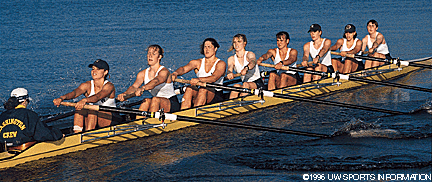
The UW women's crew team has seven national titles and 84 student-athletes. UW Sports Information photo.

"We wanted to do it the right way."

The UW women's
crew team has seven national titles and 84 student-athletes. UW Sports
Information photo.
To fund the new women's sports, Hedges was able to use revenue generated by the tremendously successful UW football program (19 consecutive winning seasons, including the 1991 national championship). "We are fortunate to have the resources to support other programs because of football," she says. "Gate revenue from football and basketball, along with private contributions, has exceeded our expenses. We manage our money well, and it paid off."
That money--which funds 10 men's sports as well as all the women's sports--helped create the new softball and soccer programs for women. Despite the significant startup costs in scholarships, coaches' salaries and equipment, no cuts were made in men's sports.
The UW now has more sports programs for women (12) than it does for men (11). But what the NCAA cares about is number of athletes. And in this case football, the golden goose for the UW and every other collegiate athletic program, is also a bugaboo.
Football teams are huge. The UW had 126 players on its football team last year, and there just isn't a women's sport with those kinds of numbers. The UW women's crew team, which has 84 athletes, is the closest. Athletic directors nationwide, struggling to achieve a balance, face a nearly impossible situation because of football.
Many have lobbied to remove football--jokingly referred to as "the third gender"--to give the rest of the sports (basketball and the other Olympic or so-called "minor" sports, such as swimming, track and field, crew, volleyball and soccer) a better chance of evening up men's and women's numbers.
"Football throws it all out of whack," says Tuite, who oversees the UW's Olympic sports. "There is almost no way to make up for the 120 players on a football team. You either need sports with high numbers of players, like crew, or you need a lot of sports. The big problem is how."
In her fifth year on the job, Hedges is ahead of the goal she had of achieving a 60/40 balance between men's and women's athletes. Of the 275 student-athletes on scholarship at the UW, 156 are men (56.7 percent) compared to 119 women (43.2 percent). Of the 664 athletes playing UW sports in 1995, 357 were men, 307 women. While the UW's total enrollment was made up of 50 percent women, women made up 46 percent of the UW's athletes.
"The UW has done a great job," says Pac-10 Assistant Commissioner Jim Muldoon. "Especially with the new soccer and softball programs. It is a remarkable story to add a new sport and have it become a national leader in such a short time."
Case Histories: Softball and Soccer
New Womens' Basketball Coach June Daugherty
Send a letter to the editor at columns@u.washington.edu.